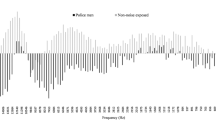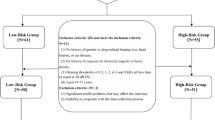Summary
Effects of noise exposure on the difference between ART1k (acoustic reflex threshold) and ARTWN ([ART1k-ARTWN]), and on the critical bandwidth (CBW) in acoustic reflex (AR) were investigated. One hundred and eleven workers using hand-held vibrating tools (exposed group) served as subjects. The results were compared with the values obtained in the control group reported by the authors previously (Miyakita and Miura 1985). The exposed group was classified into four groups according to their hearing levels (HL) at 4 and 8 kHz; i.e. Group A (HL(4k+8k)/2 < 25 dB), Group B (25 dB ≦ HL((4k+8k)/2 < 50 dB), Group C (50 dB ≦ HL((4k + 8k)/2 < 75 dB), and Group D (HL((4k+8k)/2 ≧ 75 dB). [ART1k-ARTWN] was reduced significantly (p < 0.001) in the exposed groups; i.e. 12.4 dB in the control group, 6.7 dB in Group A, 2.3 dB in Group B, −0.3 dB in Group C, and −1.3 dB in Group D. On the other hand, a significant widening of the CBW was observed in the exposed group compared to that of the control group (p < 0.05); i.e. 1138 Hz in the control group, 1410 Hz in Group A, 3287 Hz in Group B, and ≧ 4000 Hz in Groups C and D. In addition, we confirmed that the reduction of [ART1k-ARTWN] might be the result of the widening of the CBW in AR. However, there are few findings on the relationship between the widening of the CBW in AR and functional or morphological damage to the inner ear. Therefore, further investigation will be needed to establish a reliable index for noise susceptibility.
Similar content being viewed by others
References
ANSI (1969) Specifications for audiometers. ANSI [American National Standards Institute, New York], S3.6–1969
Axelsson A, Vertes D, Miller J (1981) Immediate noise effects cochlear vasculature in the guinea pig. Acta Otolaryngol 91:237–246
Berger EH, Royster LH, Thomas WG (1977) Hearing levels of nonindustrial noise exposed subjects. J Occup Med 19:664–670
Bohne BA, Rabbitt KD (1983) Holes in the reticular lamina after noise exposure: implication for continuing damage in the organ of Corti. Hearing Res 11:41–53
Dolan TR, Ades HW, Bredberg G, Neff WD (1975) Inner ear damage and hearing loss after exposure to tones of high intensity. Acta Otolaryngol 80:343–352
Glorig A, Nixon J (1962) Hearing loss as a function of age. Laryngoscope 72:1596–1610
Hamernik RP, Henderson D, Salvi R (1982) New perspectives on noise-induced hearing loss. Raven Press, New York
Hinchcliffe R (1971) Presbycusis in the presence of noise-induced hearing loss. In: Robinson DW (ed) Occupational hearing loss. Academic Press, London New York
Henderson D, Hamernik RP, Dosanjk DS, Mills JH (1976) Effects of noise on hearing. Raven Press, New York
Johansson B, Kylin B, Langfy M (1967) Acoustic reflex as a test of individual susceptibility to noise. Acta Otolaryngol 64:256–262
Konishi T, Salt AN (1983) Electrochemical profile for potassium ions across the cochlear hair cell membranes of normal and noise-induced guinea pigs. Hearing Res 11:219–233
Kryter KD (1970) The effects of noise on man. Academic Press, New York
Lawrence M, Gonzalez G, Hawkins JE (1967) Some physiological factors in noise-induced hearing loss. Am Ind Hyg Assoc J 28:425–430
Limpscomb DM, Axelsson A, Vertes D, Roettger R, Carroll J (1977) The effect of high level sound on hearing sensitivity, cochlear sensorineuroepithelium and vasculature of the chinchilla. Acta Otolaryngol 84:44–56
Miyakita T, Miura H, Yamamoto T (1983) Evaluation of noise susceptibility: effects of noise exposure on acoustic reflex. Int Arch Occup Environ Health 52:231–242
Miyakita T, Miura H (1984) Acoustic reflex in workers using hand-held vibration tools. Jpn J Ind Health 26:116–124
Miyakita T, Miura H (1985) Study on an evaluation index for noise susceptibility. I. Estimation of critical bandwidth in acoustic reflex. Int Arch Occup Environ Health 55:285–293
Møller AR (1972) The middle ear. In: Tobias JV (ed) Foundation of modern auditory theory. II. Academic Press, New York
Popelka GR, Margolis RH, Wiley TL (1976) Effects of activating signal bandwidth on acoustic-reflex thresholds. J Acoust Soc Am 59:153–159
Rauchegger H, Spoendlin H (1981) Damage of the basilar membrane by acoustic stimulation. Arch Otorhinolaryngol 232:117–122
Rosen S, Bergman M, Plester D, El-mofty A, Satti MH (1962) Presbycusis study of a relatively noise-free population in the Sudan. Ann Otol Rinol Laryngol 71:727–743
Schnieder EA (1974) A contribution to the physiology of the perilymph. III. On the origin of noise-induced hearing loss. Ann Otol Rhinol Laryngol 83:406–412
Simmons FB, Calif PA (1963) Individual sound damage susceptibility: role of middle ear muscles. Ann Otol Rhinol Laryngol 72:528–547
Spoendlin H (1971) Primary structural changes in the organ of Corti after acoustic overstimulation. Acta Otolaryngol 71:166–176
Voldřich L, Úlehlová L (1982) Correlation of the development of acoustic trauma to the intensity and time of acoustic overstimulation. Hearing Res 6:1–6
Ward WD (1965) The concept of susceptibility to hearing loss. J Occup Med 7:595–607
Ward WD (1968) Susceptibility to auditory fatigue. In: Neff WD (ed) Contribution of sensory physiology, 3. Academic Press, New York
Ward WD, Duvall AJ (1971) Behavioral and ultrastructural correlation acoustic trauma. Ann Otol Rhinol Laryngol 80:881–896
WHO (1980) Environmental health criteria 12, Noise. World Health Organization, Geneva
Yamamoto T (1975) Qualitative and quantitative assessment of high intensity noise in relation to occupational noise exposure and hearing loss. Sumitomo Bull Ind Health 11:1–19
Author information
Authors and Affiliations
Rights and permissions
About this article
Cite this article
Miyakita, T., Miura, H. Study on an evaluation index for noise susceptibility. Int. Arch Occup Environ Heath 55, 295–303 (1985). https://doi.org/10.1007/BF00377688
Received:
Accepted:
Issue Date:
DOI: https://doi.org/10.1007/BF00377688




